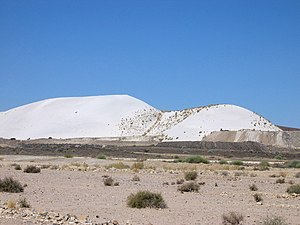Uis
Uis | |
|---|---|
Village | |
 Mine Spoils | |
| Coordinates: 21°13′7″S 14°52′3″E / 21.21861°S 14.86750°E | |
| Country | |
| Region | Erongo Region |
| Constituency | Dâures Constituency |
| Population (2010)[1] | |
| • Total | ca. 3,600 |
| Time zone | UTC+1 (South African Standard Time) |
Template:Contains Khoekhoe text
Uis is a settlement located in Erongo Region, Namibia. It belongs to the Dâures electoral constituency. Located in the former Damaraland, it is known for the local mineral wealth. The settlement has approximately 3,600 inhabitants and, before being downgraded from "village" to "settlement" in 2010, owned 10 square kilometres (3.9 sq mi) of land.[1]
Uis is located at the foot of the Brandberg, Namibia's highest mountain. The Brandberg is home to the world famous The White Lady rock painting, said by some to be over 20,000 years old. Being also situated on the C36, the main road between the coast and the Damaraland interior there is reasonable amount of traffic, by far the main source of economic activity in Uis. The settlement holds a small supermarket, guesthouses, a bakery and a petrol station, together with a few other small shops.
Uis is home to the Brandberg Primary School and Petrus ǃGaneb Secondary School, both for about 300 learners.[2] Petrus Ganeb SS was built before Namibian independence; its facilities are old and dilapidated.[3]
Mining industry
Tin has been mined in the Uis region since 1922. Uis Tin Mining Company was established in 1951 and the settlement was established in 1958 as a mine workers' residence when ISCOR, a South African mining company, started operations there and increased production. However, the ore grade at Uis is very low, and successful production is thus dependent on a high world market price.[4] The white mine spoils are still visible from afar.
In 1991, the main mining operation closed down because the price of tin dropped far enough to make it un-economical. There is still minimal work progressing on the mine site today. Technology has improved enough to make it worthwhile to re-process the already excavated ore that was originally discarded and there is a tiny re-processing plant located near the old mine dumps. This ore is processed to an enriched state and then taken to Walvis Bay for export. Uis is in danger of becoming a ghost town if mining cannot be continued. Uis was downgraded to "settlement" status in 2010.[5]
The mine and the surrounding settlement are situated on the farm Uis Townlands No. 215 and today in private hands. Since 1995 Namib Base Minerals Pty Ltd is the owner, after a subsidiary of ISCOR sold it.[6]
One product that Uis still produces is rocks and minerals. Namibia is well known as a mineral rich country and geologists come from all over the world to study in Namibia because much of the interesting geology and rare rocks are situated at ground level rather than on top of mountains or deep underground.
References
- ^ a b "ELECTIONS 2010: Erongo regional profile". New Era. 16 November 2010.
- ^ Kisting, Denver (17 January 2017). "Cholera crisis looms at Uis". The Namibian. p. 3.
- ^ Hartmann, Adam (30 May 2016). "Petrus Ganeb's hostels beg for renovation". The Namibian. pp. 6–7.
- ^ Olivier, Willie; Olivier, Sandra (2006). African Adventurer's Guide to Namibia (3 ed.). Struik. p. 234. ISBN 9781868728589.
- ^ Hartman, Adam (27 Aug 2010). "Town regrading a 'sad move'". The Namibian. Archived from the original on 11 December 2012.
{{cite news}}: Unknown parameter|deadurl=ignored (|url-status=suggested) (help) - ^ "Uis's legal history". Die Republikein. Namib Base Metals press release. 1 October 2007.

